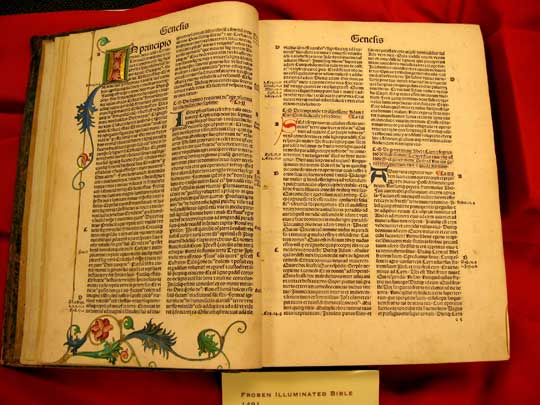Books printed before 1500, within the first fifty years of Gutenberg’s invention of printing with metal movable type, are called incunabula (in-kyə-ˈna-byə-lə), from the Latin word meaning “a cradle.” These are books from the infancy of printing. The great majority of these works were religious works, including Bibles. Several excellent incunabula are on display in the Dunham Bible Museum.
Koberger Illuminated Latin Bible, 1478 Printed approximately twenty-six years after Gutenberg’s Bible, Koberger’s 1478 Bible illustrates the blending of the new type technology of printing and the hand art of the manuscript Bible. At least seven colors of ink were used to hand decorate the pages, many times with the leaf, flower, and bird motifs going completely down the side of the page and across the bottom. Several pages are illuminated with gold. The boards of the book are original, though the spine was replaced in the 19th century, when the brass clasps were added as well.

Froben Illuminated Latin Bible, 1491 Johann Froben (1460-1527), a leading printer in Basel, Switzerland, was a friend of Erasmus. Erasmus worked with Froben to print many of the works from antiquity, as well as his own Greek-Latin edition of the Bible. Froben used available Hebrew and Greek manuscripts to correct the Latin Vulgate, which had become corrupted over the centuries. This hand illuminated edition includes prologues to each book of the Bible and a Bible dictionary at the back. Antonin Koberger (1440-1513) began printing books in Nuremberg around 1470. By 1500 he had produced 250 titles, with print runs in the thousands. At various times he had up to 18 printing presses operating and over 100 assistants, printers, and typesetters.

Koberger Latin Bible with Nicholas de Lyra’s Commentary, 4 volumes, 1493 The first Biblical commentary printed was that of Nicholas de Lyra. De Lyra (1270-1340) was a Franciscan professor at the Sorbonne in France who taught that the literal sense was most important to a proper interpretation and understanding of Scripture. He believed that the proper literal sense was often obscured by excessive mystical and allegorical interpretations, corruptions in the Vulgate texts, and copyists’ errors. In his commentary, de Lyra sought out the texts in Hebrew. His interpretations were always clear and concise, and his scholarship was respected by Jews and Christians. Martin Luther’s interpretation of Scripture owed much to Nicholas de Lyra. In Koberger’s 1493 edition, the Scripture text is printed in two columns in the center of the page, and the commentary, also in two columns, surrounds the text.
